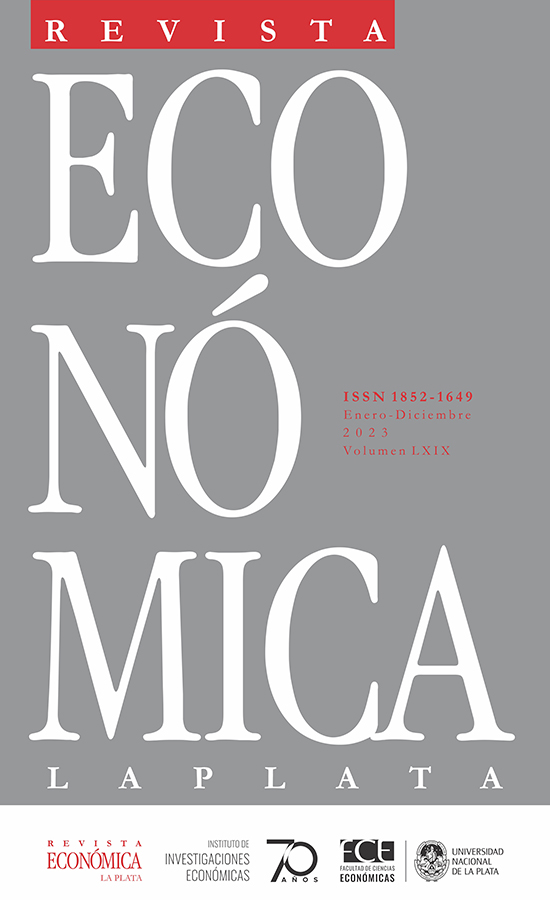Forecasting inflation with twitter
DOI:
https://doi.org/10.24215/18521649e031Keywords:
inflation, social network, forecasting, uncertainty, text analysisAbstract
We use Twitter content to generate an indicator of attention allocated to inflation. The analysis corresponds to Argentina for the period 2012-2019. The attention index provides valuable information regarding future levels of inflation. A one standard deviation increment in the index is followed by an increment of approximately 0.4% in inflation in the consecutive month. Out-of-sample exercises confirm that social media content allows for gains in forecast accuracy. Beyond point forecasts, the index provides valuable information regarding inflation uncertainty. The proposed indicator compares favorably with other indicators such as media content, media tweets, google search intensity and consumer surveys.
Downloads
Metrics
References
Ang, A., Bekaert, G. y Wei, M. (2007). Do macro variables, asset markets, or surveys forecast inflation better? Journal of monetary Economics, 54(4), 1163–1212.
Arifovic, J. (1995). Genetic algorithms and inflationary economies. Journal of Monetary Economics, 36(1), 219 243.
Aromí, J. D. (2020). Linking words in economic discourse: implications for macroeconomic forecasts. International Journal of Forecasting, 36(4), 1517 1530. https://doi.org/10.1016/j.ijforecast.2019.12.001
Ascari, G., Bonomolo, P. y Lopes, H. F. (2019). Walk on the wild side: Temporarily unstable paths and multiplicative sunspots. American Economic Review, 42(5), 123–134.
Azar, P. D. y Lo, A. W. (2016). The wisdom of twitter crowds: predicting stock market reactions to fomc meetings via twitter feeds. The Journal of Portfolio Management, 42(5), 123–134.
Baker, S. R., Bloom, N. y Davis, S. J. (2016). Measuring economic policy uncertainty. The Quarterly Journal of Economics, 131(4), 1593–1636.
Benhabib, J. y Farmer, R. (1999). Chapter 6 iIndeterminacy and sunspots in macroeconomics. En J. B. Taylor y M. Woodford (Eds.), Handbook of Macroeconomics (Vol. 1A, pp. 387–448). Elsevier.
Bollen, J., Mao, H. y Zeng, X. (2011). Twitter mood predicts the stock market. Journal of Computational Science, 2(1), 1–8.
De Grauwe, P. y Ji, Y. (2019). Inflation targets and the zero lower bound in a behavioural macroeconomic model. Economica, 86(342), 262–299.
Elder, J. (2004). Another perspective on the effects of inflation uncertainty. Journal of Money, Credit and Banking, 911–928.
Faust, J., Gilchrist, S., Wright, H. J. y Zakrajsek, E. (2013). Credit spreads as predictors of real-time economic activity: a bayesian model-averaging approach. The Review of Economics and Statistics, 95(5), 1501–1519.
Faust, J. y Wright, H. J. (2013). Chapter 1 - forecasting inflation. En G. Elliott y A. Timmermann (Eds.),
Handbook of Economic Forecasting (Vol. 2, pp. 2–56). Elsevier.
Heymann, D. y Leijonhufvud, A. (1995). High Inflation: the arne ryde memorial lectures. Oxford University Press.
Huizinga, J. (1993). Inflation uncertainty, relative price uncertainty, and investment in us manufacturing. Journal of Money, Credit and Banking, 25(3), 521–549.
Mackowiak, B. y Wiederholt, M. (2009). Optimal sticky prices under rational inattention. American Economic Review, 99(3), 769–803.
Newey, W. K. y West, K. D. (1987). A simple, positive semi-definite, heteroskedasticity and autocorrelation consistent covariance matrix. Econometrica, 55, 703–708.
Newey, W. K. y West, K. D. (1994). Automatic lag selection in covariance matrix estimation. The Review of Economic Studies, 61(4), 631–653.
Oliveira, N., Cortez, P. y Areal, N. (2017). The impact of microblogging data for stock market prediction: Using twitter to predict returns, volatility, trading volume and survey sentiment indices. Expert Systems with Applications, 73, 125–144.
Rossi, B. y Sekhposyan, T. (2010). Have economic models’ forecasting performance for us output growth and inflation changed over time, and when? International Journal of Forecasting, 26(4), 808–835.
Rossi, B. y Sekhposyan, T. (2015). Macroeconomic uncertainty indices based on nowcast and forecast error distributions. American Economic Review, 105(5), 650–655.
Schorfheide, F. y Song, D. (2015). Real-time forecasting with a mixed-frequency var. Journal of Business Economic Statistics, 33(3), 366–380.
Sharpe, S. A., Sinha, N. R. y Hollrah, C. A. (2020). The power of narratives in economic forecasts (Finance and Economics Discussion Series 2020-001r1). Federal Reserve Board.
Sims, C. (2003). Implications of rational inattention. Journal of Monetary Economics, 50(3), 665–690.
Stock, J. H. y Watson, M. W. (1999). Forecasting inflation. Journal of Monetary Economics, 44(2), 293–335.
Thorsrud, L. A. (2020). Words are the new numbers: a newsy coincident index of the business cycle. Journal of Business & Economic Statistics, 38(2), 393–409.
Published
How to Cite
Issue
Section
License
Copyright (c) 2023 Martín Llada, Daniel Aromí

This work is licensed under a Creative Commons Attribution-NonCommercial-NoDerivatives 4.0 International License.
The material published in the journal is distributed under a Creative Commons Attribution-NonCommercial-NoDerivatives 4.0 International (CC BY-NC-ND 4.0) license. This license requires proper credit to be given, a link to the license to be provided, and changes to be indicated. It does not permit commercial use of the work, and if the work is remixed, transformed, or otherwise modified, distribution of such modification is not allowed.






























